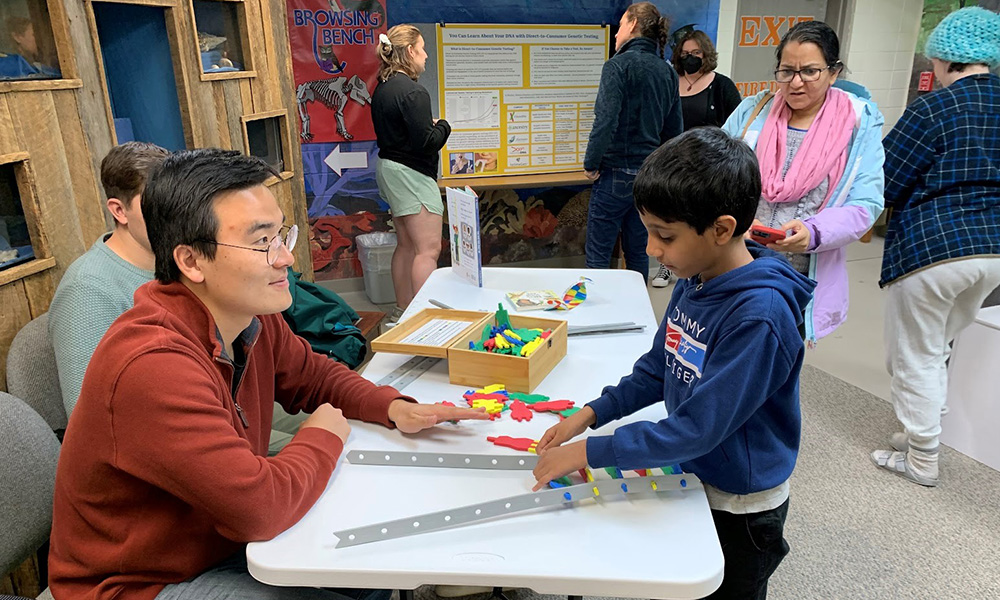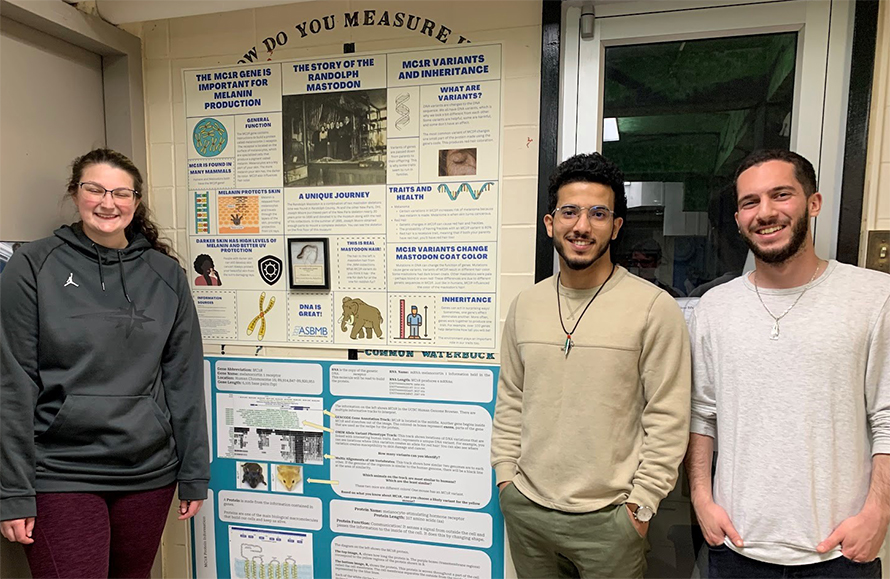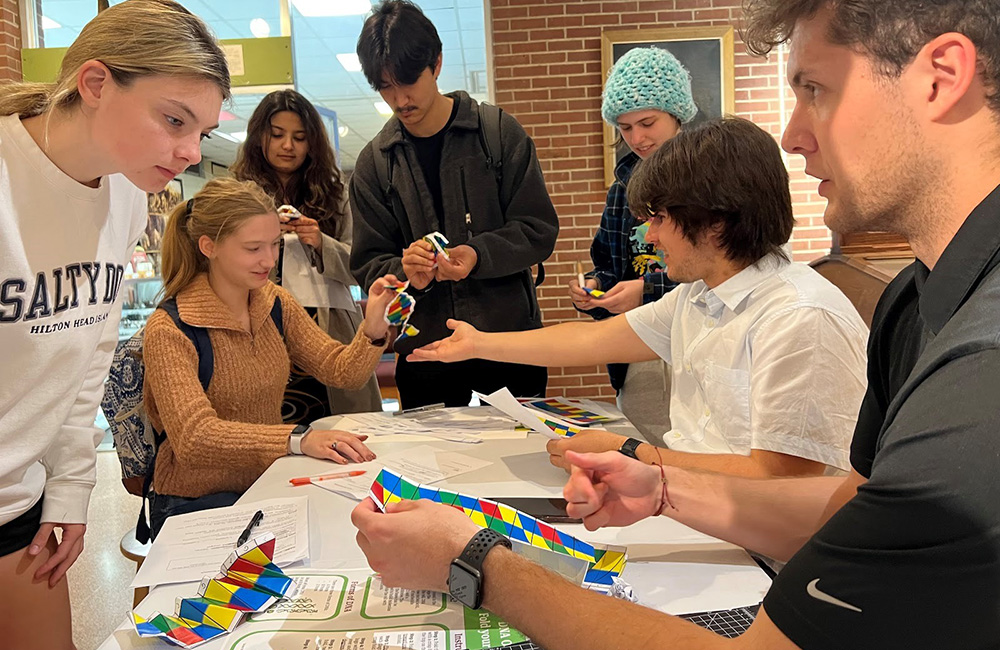Celebrating DNA Day with a new museum exhibit
“Communicate science to a broad audience via written and oral methods.”
That’s a learning goal for my class Biol351: Human Genetics and Genomics. Since I started working at Earlham College, I’ve wanted to create a DNA exhibit for the school’s Joseph Moore Museum. When I saw an advertisement in late 2022 for the American Society for Biochemistry and Molecular Biology’s Science Outreach and Communication Grant, I immediately thought of a way to integrate DNA Day, the museum and my course.

On April 25, 2023 (DNA Day),15 Earlham College undergraduates opened and established a permanent DNA exhibit at the museum, funded by the SOC grant. The students created posters and interactive activities to showcase this impressive nucleic acid.
I’m delighted that the ASBMB and my students made that happen.
The exhibit includes an atomic-level 3D DNA model, which will help teach undergraduates in introductory genetics classes; this DNA-building activity with foam nucleotides and informational posters was prepared by the Biol351 students. One poster provides basic information about DNA.
At the request of the museum director, Heather Lerner, two other posters dive deeper into MC1R,a gene related to hair color. These posters connect the gene to the mastodon skeleton in the museum and begin to introduce the concept of genetic evolution.
A final poster, which is not part of the permanent display, explains direct-to-consumer genetic testing and compares and contrasts some of the more popular services.
Meeting multiple needs
The Joseph Moore Museum provides needed scientific learning opportunities not only for Earlham students but also for the surrounding community of Richmond. As the only regional institution offering free science, technology, engineering and math programming, the museum serves about 13,000 visitors annually.
K–12 STEM proficiency has been dropping in Indiana. Scores from the local school corporation ILEARN scores for 2021–2022 showed that only 19.2% of high school students demonstrated proficiency in biology. A field trip to the museum comprises a large portion of the science curriculum for many local K–5 students. Adding a DNA exhibit targets a fundamental gap in the museum’s offerings.
To pull off the new exhibit, I ordered the model and foam building blocks from 3D Molecular Designs. Then the students got involved. I had them complete a museum critique before they began creating their own posters. They visited the museum, and each dissected the effectiveness of one.
Students signed up for specific posters or activities and worked together in small groups (2–3 students) to complete them. We sent drafts of the posters to museum employees for review and feedback. They told us that girls are more likely to engage with exhibits that display faces, so we tried to include photos and graphics of human faces on the posters.
On DNA Day, the museum held an open house for the community. Most visitors that day were students enrolled in Biol112: Cells, Genes and Inheritance, who used the opportunity to study for their final exam and earn extra credit by filling in a worksheet. This class is one of the target audiences for this exhibit; the DNA model and posters will be used to help instruct Biol112 students in the future. Community members who saw our Facebook post also attended.

A good beginning
We learned some valuable lessons. We agreed that more interactive stations would improve visitors’ understanding of the posters and provide opportunities for conversation. For a future DNA Day Open House, we could add a DNA extraction station or include a microscope showing an animal cell’s nucleus.
Students said they wanted more time to work on their posters. The initial plan was to have two rounds of feedback, not just one, but that changed as the semester progressed. Also, we were unable to have a classroom visit from a museum rep, which would have helped us better understand how to design the posters and what kind of language to use. However, we are happy with the first iteration of the exhibit and look forward to improvements in version 2.0.
Version 2.0 will include a long spool of DNA — the sequence of MC1R — that museum guests can unroll (and hopefully re-wind). I want people to appreciate how long a gene actually is and then be amazed at how the genome is efficiently packaged into our cells. We didn’t have time this semester to pull off that idea, but we’ll make it happen for the next iteration of the exhibit.

Submit your proposal
Applications for ASBMB Science Outreach and Communication Grants are now being accepted. The deadline for this cycle is Oct. 31, and results will be announced in January. Learn more and apply.
Enjoy reading ASBMB Today?
Become a member to receive the print edition four times a year and the digital edition monthly.
Learn moreGet the latest from ASBMB Today
Enter your email address, and we’ll send you a weekly email with recent articles, interviews and more.
Latest in Education
Education highlights or most popular articles

Sketching, scribbling and scicomm
Graduate student Ari Paiz describes how her love of science and art blend to make her an effective science communicator.

Using DNA barcodes to capture local biodiversity
Undergraduate at the University of California, Santa Barbara, leads citizen science initiative to engage the public in DNA barcoding to catalog local biodiversity, fostering community involvement in science.

Embrace your neurodivergence and flourish in college
This guide offers practical advice on setting yourself up for success — learn how to leverage campus resources, work with professors and embrace your strengths.

Survival tools for a neurodivergent brain in academia
Working in academia is hard, and being neurodivergent makes it harder. Here are a few tools that may help, from a Ph.D. student with ADHD.

Quieting the static: Building inclusive STEM classrooms
Christin Monroe, an assistant professor of chemistry at Landmark College, offers practical tips to help educators make their classrooms more accessible to neurodivergent scientists.

Hidden strengths of an autistic scientist
Navigating the world of scientific research as an autistic scientist comes with unique challenges —microaggressions, communication hurdles and the constant pressure to conform to social norms, postbaccalaureate student Taylor Stolberg writes.

